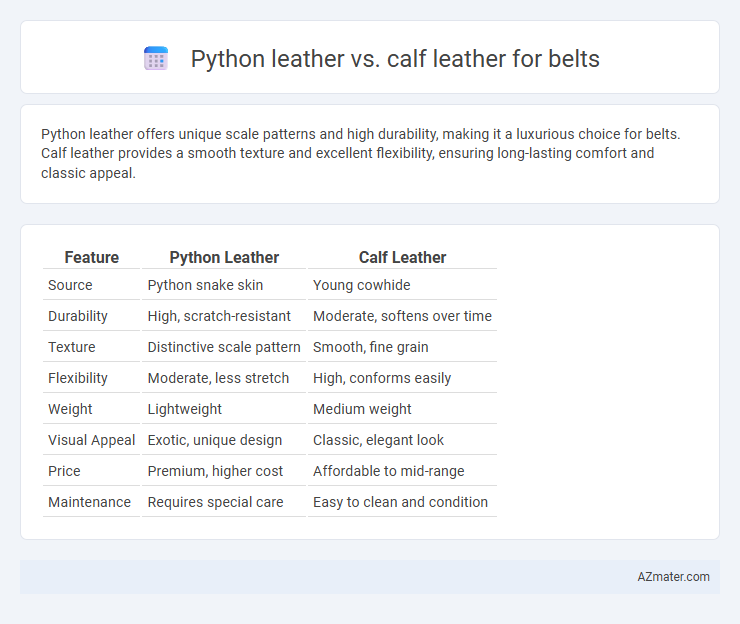Python leather offers unique scale patterns and high durability, making it a luxurious choice for belts. Calf leather provides a smooth texture and excellent flexibility, ensuring long-lasting comfort and classic appeal.
Table of Comparison
| Feature | Python Leather | Calf Leather |
|---|---|---|
| Source | Python snake skin | Young cowhide |
| Durability | High, scratch-resistant | Moderate, softens over time |
| Texture | Distinctive scale pattern | Smooth, fine grain |
| Flexibility | Moderate, less stretch | High, conforms easily |
| Weight | Lightweight | Medium weight |
| Visual Appeal | Exotic, unique design | Classic, elegant look |
| Price | Premium, higher cost | Affordable to mid-range |
| Maintenance | Requires special care | Easy to clean and condition |
Introduction to Python Leather and Calf Leather
Python leather, derived from the skin of pythons, is prized for its distinctive scale pattern and durability, making it a luxurious choice for belts that require both strength and style. Calf leather, sourced from young cattle, is known for its smooth texture, suppleness, and fine grain, offering a classic appearance with long-lasting flexibility. Both materials provide unique aesthetic and functional qualities, but python leather stands out for its exotic appeal while calf leather is favored for its softness and traditional look.
Visual Appeal: Texture and Pattern Differences
Python leather showcases a distinctive, intricate scale pattern that creates a bold, exotic visual appeal, making each belt uniquely textured with natural variations. Calf leather, known for its smooth and fine grain, offers a classic, polished look with subtle texture that adds elegance and sophistication to belt designs. The choice between python and calf leather hinges on the desired aesthetic, with python delivering dramatic patterning and calf leather providing consistent, refined surface quality.
Durability and Strength Comparison
Python leather exhibits high durability due to its dense scale structure, providing excellent resistance to wear and tear for belts. Calf leather, known for its fine grain and natural elasticity, offers strong tensile strength while maintaining flexibility, making it less prone to cracking over time. For long-lasting belts, calf leather typically outperforms python leather in strength and overall durability under constant stress and bending.
Comfort and Flexibility in Daily Wear
Python leather offers superior flexibility and molds comfortably to the wrist with regular wear, making it ideal for daily use due to its lightweight and supple texture. Calf leather provides a balanced combination of softness and sturdiness, offering reliable comfort through a natural grain that breathes well and adapts over time. Both materials maintain durability, but python leather's unique scale structure enhances flexibility whereas calf leather emphasizes consistent comfort for extended wear.
Maintenance and Care Requirements
Python leather requires more delicate maintenance than calf leather due to its unique scale texture, which can easily trap dirt and moisture. Regularly applying a specialized leather conditioner and avoiding excessive moisture helps preserve the python leather's flexibility and sheen. Calf leather benefits from routine cleaning and conditioning with standard leather care products, offering more straightforward upkeep and enhanced durability for everyday belt use.
Price Differences and Value for Money
Python leather belts generally command a higher price than calf leather belts due to their exotic status and intricate scale patterns, making them a luxury choice in the market. Calf leather belts offer a more affordable option while providing excellent durability and a classic look, appealing to budget-conscious consumers seeking long-lasting value. The value for money hinges on personal preference for exclusivity versus practical longevity, with calf leather delivering consistent quality at a lower price point.
Ethical and Sustainability Considerations
Python leather production often raises ethical concerns due to the hunting and farming practices that can threaten wild snake populations and disrupt ecosystems. Calf leather typically comes from cattle raised in industrial farming systems, which contribute significantly to greenhouse gas emissions and deforestation, posing sustainability challenges. Choosing ethically sourced, certified leather alternatives such as vegetable-tanned calf leather or lab-grown python leather can mitigate environmental impact and support more sustainable fashion practices.
Fashion Versatility and Styling Options
Python leather belts offer a bold, exotic texture and striking scale patterns that elevate fashion versatility with a distinctive, high-end look, ideal for statement accessories and luxury styling. Calf leather belts provide a smooth, refined finish and classic appeal, allowing seamless integration into both casual and formal wardrobes, thus offering timeless versatility. Combining these leathers with various outfits enhances styling options by balancing unique pattern aesthetics with understated elegance.
Availability and Sourcing of Materials
Python leather, sourced primarily from Southeast Asia, is less abundant due to strict wildlife regulations and sustainable harvesting practices, making it a rarer option for premium belts. Calf leather, widely sourced from global cattle farms, benefits from established supply chains and high availability, contributing to its consistent use in belt manufacturing. The sourcing of python leather involves CITES permits to ensure ethical procurement, whereas calf leather is typically sourced with fewer regulatory restrictions, impacting overall material accessibility.
Which Leather is Best for Your Belt?
Python leather offers a unique, exotic texture with natural scale patterns, making it a stylish choice for belts that stand out and convey luxury. Calf leather, known for its smooth surface, durability, and flexibility, provides a classic, long-lasting option that ages beautifully with use. For belts, calf leather is often considered the best all-around choice due to its balance of comfort, strength, and timeless appeal, while python leather suits those prioritizing distinctive aesthetics and high-end fashion statements.

Infographic: Python leather vs Calf leather for Belt
 azmater.com
azmater.com